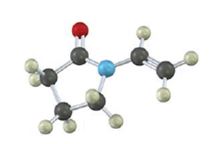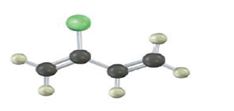
Concept explainers
a)

Interpretation:
Draw the structures of the
Concept introduction:
The term “polymer” is derived from the two words poly+mer. Where poly means ‘many’ and mer means ‘unit’, when combined known as polymer. The
The reaction mechanism may be classified into two categories:
Chain growth polymerization:
Chain growth polymers are produced by chain growth polymerization or addition polymerization. In this process an initiator is added to the reaction mixture. This initiator gets added to the carbon-carbon double bond and yields a reactive monomer (intermediate). This reactive intermediate reacts with the monomer and this process keeps on repeating to give rise to final polymeric product.
Step growth polymerization:
Step growth polymers are produced by step growth polymerization or condensation polymerization. In this process, each bond is formed in a step wise manner. In this the product of each is again a bi-
b)

Interpretation:
Draw the structures of the polymers formed by the given monomer units.
Concept introduction:
The term “polymer” is derived from the two words poly+mer. Where poly means ‘many’ and mer means ‘unit’, when combined known as polymer. The polymerization is the process of reacting monomer molecules together in a chemical reaction to give rise to a polymer. If the reacting units are same then this type of polymer is known as homopolymer and if the reaction takes place between different molecules then it is called copolymer.
The reaction mechanism may be classified into two categories:
Chain growth polymerization:
Chain growth polymers are produced by chain growth polymerization or addition polymerization. In this process an initiator is added to the reaction mixture. This initiator gets added to the carbon-carbon double bond and yields a reactive monomer (intermediate). This reactive intermediate reacts with the monomer and this process keeps on repeating to give rise to final polymeric product.
Step growth polymerization:
Step growth polymers are produced by step growth polymerization or condensation polymerization. In this process, each bond is formed in a step wise manner. In this the product of each is again a bi-functional group and the condensation goes on.
Want to see the full answer?
Check out a sample textbook solution
Chapter 31 Solutions
EBK ORGANIC CHEMISTRY
- Nonearrow_forwardTransmitance 3. Which one of the following compounds corresponds to this IR spectrum? Point out the absorption band(s) that helped you decide. OH H3C OH H₂C CH3 H3C CH3 H3C INFRARED SPECTRUM 0.8- 0.6 0.4- 0.2 3000 2000 1000 Wavenumber (cm-1) 4. Consider this compound: H3C On the structure above, label the different types of H's as A, B, C, etc. In table form, list the labeled signals, and for each one state the number of hydrogens, their shifts, and the splitting you would observe for these hydrogens in the ¹H NMR spectrum. Label # of hydrogens splitting Shift (2)arrow_forwardNonearrow_forward
- Draw the Lewis structure of C2H4Oarrow_forwarda) 5. Circle all acidic (and anticoplanar to the Leaving group) protons in the following molecules, Solve these elimination reactions, and identify the major and minor products where appropriate: 20 points + NaOCH3 Br (2 productarrow_forwardNonearrow_forward
- Dr. Mendel asked his BIOL 260 class what their height was and what their parent's heights were. He plotted that data in the graph below to determine if height was a heritable trait. A. Is height a heritable trait? If yes, what is the heritability value? (2 pts) B. If the phenotypic variation is 30, what is the variation due to additive alleles? (2 pts) Offspring Height (Inches) 75 67.5 60 52.5 y = 0.9264x + 4.8519 55 60 65 MidParent Height (Inches) 70 75 12pt v V Paragraph B IUA > AT2 v Varrow_forwardExperiment: Each team will be provided with 5g of a mixture of acetanilide and salicylic acid. You will divide it into three 1.5 g portions in separate 125 mL Erlenmeyer flasks savıng some for melting point analysis. Dissolve the mixture in each flask in ~60mL of DI water by heating to boiling on a hotplate. Take the flasks off the hotplate once you have a clear solution and let them stand on the bench top for 5 mins and then allow them to cool as described below. Sample A-Let the first sample cool slowly to room temperature by letting it stand on your lab bench, with occasional stirring to promote crystallization. Sample B-Cool the second sample 1n a tap-water bath to 10-15 °C Sample C-Cool the third sample in an ice-bath to 0-2 °C Results: weight after recrystalization and melting point temp. A=0.624g,102-115° B=0.765g, 80-105° C=1.135g, 77-108 What is the percent yield of A,B, and C.arrow_forwardRel. Intensity Q 1. Which one of the following is true of the compound whose mass spectrum is shown here? Explain how you decided. 100 a) It contains chlorine. b) It contains bromine. c) It contains neither chlorine nor bromine. 80- 60- 40- 20- 0.0 0.0 TT 40 80 120 160 m/z 2. Using the Table of IR Absorptions how could you distinguish between these two compounds in the IR? What absorbance would one compound have that the other compound does not? HO CIarrow_forward
 Chemistry & Chemical ReactivityChemistryISBN:9781133949640Author:John C. Kotz, Paul M. Treichel, John Townsend, David TreichelPublisher:Cengage Learning
Chemistry & Chemical ReactivityChemistryISBN:9781133949640Author:John C. Kotz, Paul M. Treichel, John Townsend, David TreichelPublisher:Cengage Learning Chemistry: Principles and ReactionsChemistryISBN:9781305079373Author:William L. Masterton, Cecile N. HurleyPublisher:Cengage Learning
Chemistry: Principles and ReactionsChemistryISBN:9781305079373Author:William L. Masterton, Cecile N. HurleyPublisher:Cengage Learning Introductory Chemistry: An Active Learning Approa...ChemistryISBN:9781305079250Author:Mark S. Cracolice, Ed PetersPublisher:Cengage Learning
Introductory Chemistry: An Active Learning Approa...ChemistryISBN:9781305079250Author:Mark S. Cracolice, Ed PetersPublisher:Cengage Learning ChemistryChemistryISBN:9781305957404Author:Steven S. Zumdahl, Susan A. Zumdahl, Donald J. DeCostePublisher:Cengage Learning
ChemistryChemistryISBN:9781305957404Author:Steven S. Zumdahl, Susan A. Zumdahl, Donald J. DeCostePublisher:Cengage Learning Chemistry: An Atoms First ApproachChemistryISBN:9781305079243Author:Steven S. Zumdahl, Susan A. ZumdahlPublisher:Cengage Learning
Chemistry: An Atoms First ApproachChemistryISBN:9781305079243Author:Steven S. Zumdahl, Susan A. ZumdahlPublisher:Cengage Learning





